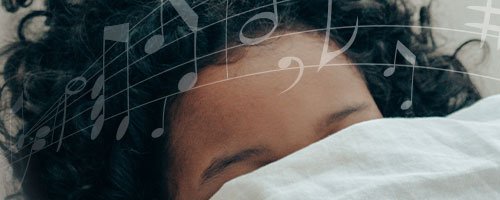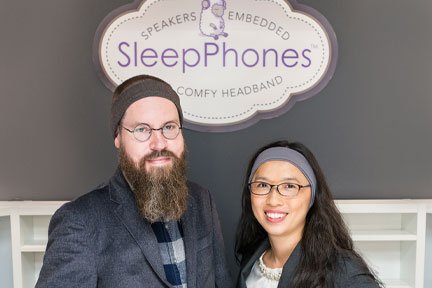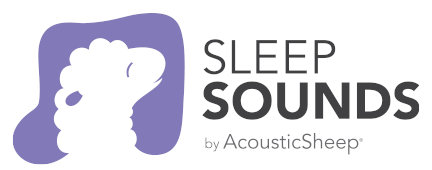Lullabies for All: How Sound Can Help Adults Sleep Better
Certain sounds can help us sleep better. But no one really knows which ones actually work. A new experiment aims to change that.
Chances are you know a lullaby or two (or even twenty). "Twinkle, Twinkle, Little Star," "Rock-a-bye Baby," "Hush Little Baby"–these and many other lullabies have been sung by parents through the millenia. (That's no exaggeration–one of the oldest known lullabies is a 5,000 year old Babylonian song.)

Babies and lullabies go hand in hand for good reason. Research shows that even unfamiliar music calms babies more than spoken language. What's more, infants remained calm twice as long when listening to a children's song they didn't know than they did while listening to baby talk. (Music to the ears of exhausted parents everywhere, right?)
Why Lullabies Work
When it comes to why lullabies are so effective, many people will mention the bonding that happens between the parent and child. They'll also point to the fact that singing a lullaby establishes an all-important bedtime routine that sets the stage for sleep.
While both points have merit, there's something more scientific going on. Lullabies, like all music, have a strong emotional influence on their listeners. Music stimulates certain neural connections, which in turn elicits emotions. For babies, this could be feelings of love, safety, and calm.
Researchers also believe that the rhythm undergirding lullabies keeps infants captivated. Lullabies have steady beats, melodies, and words while baby talk lacks any kind of predictability. It's that predictability that soothes babies so well. (And why parents often sing the same lullabies over and over and over again…).
Leaving Lullabies Behind
At a certain point, we stop singing our children to sleep. Instead, they fall asleep the way most adults do: in total, complete silence.
For most parents and kids, ditching lullabies is the goal. After all, what child wants their parents signing to them ad infinitum? And what parent wants to sing to their child with no foreseeable end in sight?
Silence being the ideal condition for sleep is widely accepted and rarely questioned. (Today, only 5% of all adults use sound to help them fall asleep. ) But maybe it should be questioned in light of research showing how sound can help us get needed rest.
For starters, let's consider the big three: white noise, pink noise, and binaural beats. You've probably heard of white noise–the staticy sound that creates a background noise that helps block out ambient noises. Research shows it's great for babies. (One study revealed that white noise helped more than three times as many newborns fall asleep within five minutes.) Research also reveals that white noise benefits adults by reducing sleep latency, or the time spent tossing and turning before falling asleep.
Another buzzed-about sleep sound is pink noise. While similar to white noise, pink noise tends to sound more balanced thanks to being louder and more powerful at the lower frequency sounds. Research shows that pink noise helps people sleep better and improves their memory functioning.
The final of the "big three" sleep sounds is binaural beats. This soundwave therapy involves the right and left ears hearing two slightly different tones but perceiving them as one tone. This perceived tone helps to induce the relaxing delta waves that are emitted during deep sleep.
In addition to the "big three," there are other sounds like nature sounds and soft music that people use to fall asleep. All told, there are thousands of different sounds that help bring on the zzz's. And while many people have their own personal sleep sound preferences, no one really knows which ones work best when it comes to helping people sleep better.
Sound: The Final Frontier in the Fight for Sleep

It's no understatement to say that the state of sleep is dismal. It’s estimated that between 50 and 70 million Americans suffer from a sleep disorder. And about four percent of Americans use prescription sleep aids–a troubling reality considering that many pills can become addictive.
The market has noticed and responded to the sleep crisis with a bevy of products that promise to help the restless get more and better zzz's. Of particular note is the explosion of so-called "sleep tech". At the annual Consumer Electronics Show that bills itself as the world's gathering place for those who thrive on the business of consumer technologies, you'll find no lack of devices that harness the power of technology to promote better sleep.
Just a very small sampling of the products you can now buy to improve your sleep include smart beds that change temperature, pillow inserts to control snoring, bedside light machines, and hundreds of different sleep trackers.
You can also choose from a wide array of sound machines and apps that crank out white noise, hypnotherapy, the soothing sounds of nature (think chirping birds and babbling brooks), and everything in between. Even good old Alexa, Amazon's popular virtual assistant, will cue up a sleep app with more than 125 soothing sounds. Heartbeats, cat purrs, Native American flute playing–all this and much more is there for your listening pleasure.
With so many choices, it's normal to wonder which (if any) sounds actually work. Is there such a thing as an "adult lullaby", or is the explosion of sleep-promoting sounds more sizzle than steak?
Discovering the Ultimate Adult Lullaby
That question lingered in the minds of Dr. Wei-Shin Lai and her husband Jason Wolfe. The duo are the inventors of SleepPhones®, the world's first and most comfortable headphones for sleeping.

Jason and Wei-Shin were inspired to create SleepPhones® back in 2007. At the time, Wei-Shin would get late night calls from patients and couldn't fall back asleep. Jason suggested she listen to binaural beats in bed, but only bulky headphones or uncomfortable earbuds were on the market. So the husband-wife team created the first SleepPhones® at their kitchen table. Billed as "pajamas for your ears," SleepPhones® feature flat speakers in a soft, stretchy headband so you can easily tune into your favorite audio in bed.
Wei-Shin’s patients proved to be a receptive audience. Several people were able to come off sleeping pills for the first time in years while one woman claimed that SleepPhones® helped save her marriage because she could finally rejoin her snoring husband in the marital bed.
SleepPhones® were so successful that both Wei-Shin and Jason quit their day jobs to sell them full time. To date, more than one million SleepPhones® have been sold all around the world and the product has won many prestigious awards.
Many customers over the years have asked what they can listen to with SleepPhones®. The stock answer has always been whatever you want, whether that’s music, meditation, white noise, audio books, ASMR, podcasts, or anything else that relaxes you. Jason and Wei-Shin often recommend a white noise app they like and send customers six free binaural beats tracks. But beyond that, they mostly remained agnostic about what SleepPhones® customers listened to.
That changed in 2015 after attending CES, the annual trade show organized by The Consumer Technology Association. Jason, a former video game developer, began brainstorming product ideas after noticing an increase in products and apps promoting sounds for sleep flooding the market. These products claimed to provide better sleep through sound, but very few substantiated those claims with any evidence.
This bothered Jason, and as the co-inventor of the self-proclaimed "world's most comfortable headphones for sleeping" with a deep interest in technology and artificial intelligence, he decided to scientifically uncover which sounds brought on the sleep that seems to evade so many of us.
Sleep Sounds by AcousticSheep® Takes Shape
While Jason started working on what came to be known as Sleep Sounds by AcousticSheep® back in 2015, his quest to develop the perfect soundtrack for sleeping took a few years to organize. For starters, he wanted to create a product that both fulfilled his own curiosity around sound-induced sleep science while also providing the end user with a truly meaningful experience. This meant he had to develop a technology that would both protect and support those users by providing the highest quality, original content available.
Fortunately, AcousticSheep's home turf—Erie, PA, is home to a Penn State branch campus with a strong computer science program. So in the summer of 2018 Jason wrangled together a team of talented interns and got to work on advancing the science of sleep through sound.
The team spent the better part of a year creating and refining Sleep Sounds by AcousticSheep®. Feedback from initial testers proved invaluable in tweaking the revolutionary sleep improvement tool to deliver a better experience for users on the front end and improved artificial intelligence operations on the back end.
Sleep Sounds by AcousticSheep® isn't like other apps that claim to help you sleep better. It's goal is more lofty - namely, to scientifically determine the most effective sounds for inducing and maintaining sleep.
It works by producing computer-generated music that incorporates various, layered sound technologies. These technologies are thought to influence brain physiology, and each soundscape is designed to both prime the listener for sleep and usher them off to dreamland, all at the same time.
Users, or "Dreamers" as we like to call them, then rate the sounds based on how well they worked at achieving this goal. Highly rated soundscapes live on, but not in their original forms. Instead, they combine with other highly rated sounds to produce something totally new. You can think of the soundscapes as genes that keep combining with other genes to produce a totally new genetic creation.
The entire sound ecosystem is powered by a sophisticated algorithm created by Jason and his team. As far as they know, there's no other sleep improvement tool that employs artificial intelligence with user input to uncover the best sounds for sleep.
The Ultimate Adult Lullaby–and Beyond

While lots of study has gone into how and why lullabies work for small children, not nearly as much attention has been paid to how sounds can help adults sleep better. But that hasn’t stopped the proliferation of products that promise to solve sleep issues with just the right sounds.
Sleep Sounds by AcousticSheep® might very well change all that. The app officially launched on August 12, 2019, on the Apple Store, Google Play, and Amazon Appstore. As you read this, sounds are combining to create newer and ever more effective sleep promoting soundscapes.
While sleep is their primary focus, Jason and Wei-Shin envision using the technology for other life-improving functions. For example, this technology could one day uncover the kinds of sounds that help people focus, experience joy, and more. The technology powering Sleep Sounds by AcousticSheep® may even work on improving upon traditional lullabies by testing sounds that help babies fall asleep faster.
But that's for another time. Right now, the focus is on helping the millions of adults who suffer from poor sleep get better rest naturally through sound. If your sleep could be better, check out Sleep Sounds by AcousticSheep®. Every piece of input brings us one step closer to creating the adult lullaby so many of us need, now more than ever.
Sleep Sounds by AcousticSheep® is available for download on the Apple Store, Google Play, and Amazon Appstore. Visit our website to learn more.
